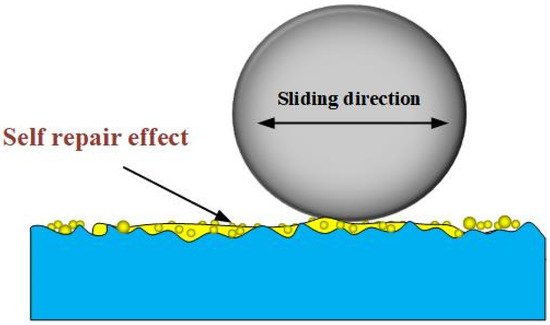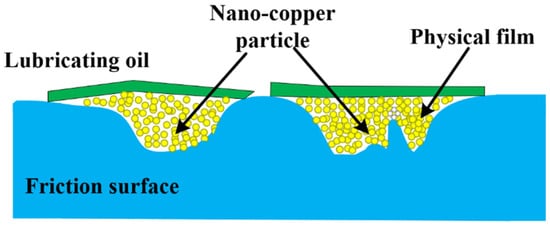
| Version | Summary | Created by | Modification | Content Size | Created at | Operation |
|---|---|---|---|---|---|---|
| 1 | Junde Guo | + 2105 word(s) | 2105 | 2021-12-16 09:24:45 | | | |
| 2 | Beatrix Zheng | + 23 word(s) | 2128 | 2021-12-20 04:45:03 | | |
Video Upload Options
Nanoparticles have as characteristics super sliding, extreme pressure, self-healing, etc., which can improve the friction reduction and anti-wear performance of sliding components, when used as lubricating oil additives. Nano-copper particles have a good synergistic effect with other antifriction agents, anti-wear agents, antioxidants and grease additives because of their low shear strength and grain boundary slip effect, showing a better anti-friction and anti-wear effect. However, nanoparticles are prone to conglomerate, and this causes a bottleneck in the application of dispersant for nano-copper in a lubricating oil system. The regulation of nanosized effect and surface properties has great engineering significance in compensating for the precision in manufacturing accuracy.
1. Introduction
2. Lubrication Mechanism of Nano-Copper as Additives
2.1. Forming Mechanism of Lubrication Film


2.2. Self-Repair Mechanism

2.3. Micro-Rolling Bearing Effect


2.4. Lubrication Theory and Simulation of Nanoparticle Lubricating Oil Additives
References
- Zhang, Y.D.; Yan, J.S.; Sun, L.; Yang, G.B.; Zhang, Z.J.; Zhang, P.Y. Friction Reducing Anti-wear and Self-repairing Properties of Nano-Cu Additive in Lubricating Oil. Chin. J. Mech. Eng. 2010, 46, 74–79.
- Fan, F.Q.; Zhang, C.Y.; Zhou, K.; Huang, Q.; Tang, Z.P.; Yu, Q.L.; Cal, M.R. Tribological properties of lubricating additives of phosphorus-based halogen-free oil-soluble ionic liquid. China Surf. Eng. 2020, 33, 136–143.
- Chen, J.; Wang, X.L.; Xu, B.S.; Xu, Y.; Zhang, G.Q. Tribological properties of regenerative diesel engine lubricating oil. Mater. Prot. 2012, 45, 27–29.
- Ali, I.; Basheer, A.A.; Kucherova, A.; Memetovd, N.; Paskod, T.; Ovchinnikov, K.; Pershind, V.; Kuznetsovf, D.; Galunind, E.; Grachevg, V.; et al. Advances in carbon nanomaterials as lubricants modifiers. J. Mol. Liq. 2019, 279, 251–266.
- Zhang, C.H. Interaction between anti friction additive and surface. Surf. Technol. 2020, 49, 6–7.
- Li, J.S.; Hao, L.F.; Xu, X.H.; Zhang, L. Preparation and Tribological Properties of surface modified copper nanoparticles. China Surf. Eng. 2010, 23, 32–37.
- Wu, W.; Liu, J.; Li, Z.; Zhao, X.Y.; Liu, G.Q.; Liu, S.J.; Ma, S.H.; Li, W.M.; Liu, W.M. Surface- functionalized nanomofs in oil for friction and wear reduction and antioxidation. Chem. Eng. J. 2021, 410, 128306.
- Kotia, A.; Chowdary, K.; Srivastava, I.; Ghosh, S.K.; Ali, M.K.A. Carbon nanomaterials as friction modifiers in automotive engines: Recent progress and perspectives. J. Mol. Liq. 2020, 310, 113200.
- Liu, W.M.; Xue, Q.J.; Zhou, J.F.; Zhang, Z.J. Study on the anti-wear effect of nanoparticles and its application as wear repair additive. China Surf. Eng. 2001, 14, 21–23.
- Zhang, Y.J.; Zhang, S.M.; Sun, D.; Yang, G.B.; Gao, C.P.; Zhou, C.H.; Zhang, C.L.; Zhang, P.Y. Wide adaptability of Cu nano-additives to the hardness and composition of DLC coatings in DLC/PAO solid-liquid composite lubricating system. Tribol. Int. 2019, 138, 184–195.
- Zhang, Y.D.; Yan, J.S.; Yu, L.G.; Zhang, P.Y. Effect of nano-Cu lubrication additive on the contact fatigue behavior of steel. Tribol. Lett. 2010, 37, 203–207.
- Borda, F.L.; Oliveira, S.J.; Lazaro, L.; Leiroz, A.J. Experimental investigation of the tribological behavior of lubricants with additive containing copper nanoparticles. Tribol. Int. 2018, 117, 52–58.
- Tepper, S. Study of friction reduction by nanocopper additives to motor oil. Wear 2002, 252, 63–69.
- Jiang, Z.W.; Hu, C.Y.; Shi, Y.; Zhang, C. Migration of copper from nano-copper/polypropylene composite films and its effects on the properties of films. Food Ferment. Ind. 2019, 22, 100416.
- Shi, Y.J.; Wrona, M.; Hu, C.Y.; Nerin, C. Copper release from nano-copper/polypropylene composite films to food and the forms of copper in food simulants. Innov. Food Sci. Emerg. Technol. 2021, 67, 102581.
- Zhang, M.; Wang, X.B.; Fu, X.S.; Liu, W.M. Self repairing behavior and mechanism of oil soluble nano Cu under fretting wear. J. Tribol. 2005, 25, 504–509.
- Yang, F.; Xia, X.L.; Xu, C. Self- repairing mechanism and tribological properties of nano-Cu as lubricating oil additives. Mater. Prot. 2018, 51, 22–25.
- Ye, F.X.; Sun, X. Nanoindentation response analysis of TiN-Cu coating deposited by magnetron sputtering. Prog. Nat. Sci. Mater. Int. 2018, 28, 40–44.
- Liu, G.; Li, X.; Qin, B.; Xing, D.; Guo, Y.; Fan, R. Investigation of the mending effect and mechanism of copper nano-particles on a tribologically stressed surface. Tribol. Lett. 2004, 17, 961–966.
- Ali, M.; Hou, X.J.; Abdelkareem, M.A.A. Anti-wear properties evaluation of frictional sliding interfaces in automobile engines lubricated by copper/graphene nanolubricants. Friction 2020, 8, 905–916.
- Mori, S. Boundary lubrication from the viewpoint of surface chemistry: Role of nascent surface on tribochemical reaction of lubricant additives. JTEKT Eng. J. 2010, 1008, 2–12.
- Zhou, P.A. Functional characteristics and application prospects of metal wear self repairing materials. China Surf. Eng. 2004, 17, 39–41.
- Shi, P.J.; Yu, H.L.; Wang, H.M.; Xu, B.S. Tribological behaviour of surface modified copper nanoparticles as lubricating additives. Phys. Procedia. 2013, 50, 461–465.
- Chen, W.C.; Cheng, J.G.; Chen, H.P. Nanosized copper powders prepared by gel-casting method and their application in lubricating oil. China J. Nonferrous Met. 2018, 28, 1186–1191.
- Wang, X.L.; Xu, B.S.; Xu, Y.; Shi, P.J.; Yu, H.L.; Zhao, Y. Application of nano copper additive in equipment repair technology. China Surf. Eng. 2006, 34, 134–136.
- Wang, J.; Guo, X.; Mi, H. Effect of nano-coppers with different dimensions on tribological properties of lithium grease. China Pet. Process. Petrochem. Technol. 2020, 22, 118–126.
- Tevet, O.; Von-Huth, P.; Popovitz-Biro, R.; Rosentsveig, R.; Wangner, H.D.; Tenne, R. Friction mechanism of individual multilayered nanoparticles. Proc. Natl. Acad. Sci. USA 2011, 108, 19901–19906.
- Chen, Z.; Liu, X.; Liu, Y.; Gunsel, S.; Luo, J. Ultrathin MoS2 nanosheets with superior extreme pressure property as boundary lubricants. Sci. Rep. 2015, 5, 12869.
- Wu, H.; Yin, S.; Du, Y.; Wang, L.; Wang, H. An investigation on the lubrication effectiveness of MoS2 and BN layered materials as oil additives using block-on-ring tests. Tribol. Int. 2020, 151, 106516.
- Spikes, H. Friction modifier additives. Tribol. Lett. 2015, 60, 1–26.
- Xia, Y.Q.; Chen, C. Tribological properties of serpentine powder/soft metal nanoparticles as complex lithium-based grease additive petroleum. Process. Petrochem. 2020, 51, 58–62.
- Igor, U.E.; Vladimir, A.Z.; Victoria, E.B. Metal-containing nanomaterials as lubricant additives: State-of-the-art and future development. Friction 2019, 7, 93–116.
- He, Q.; Li, A.L.; Zhang, Y.M.; Liu, S.F.; Guo, Y.C. Experimental study of tribological properties of lithium-based grease with Cu nanoparticle additive. Tribol. Mater. Surf. Interfaces 2017, 11, 1–8.
- Zhang, L.; Hong, G.; Cai, S. Molecular dynamics simulation of aggregation of monocrystal and polycrystal copper nanoparticles. Int. J. Mod. Phys. B 2019, 33, 1950168.
- Chen, C.S.; Cian, H.J.; Yu, C.H.; Huang, C.W. Friction coefficient calculation and mechanism analysis for MoS2 nanoparticle from molecular dynamics simulation. Procedia Eng. 2014, 79, 617–621.
- Leng, Y.F.; Liu, Y.U.; Li, Q. Molecular dynamics simulation of the mechanism of increasing thermal conductivity of ricinoleic acid by nano copper. Lubr. Eng. 2021, 46, 68–73.
- Wu, H.; Qin, L.; Dong, G.; Hua, M.; Yang, S.; Zhang, J. An investigation on the lubrication mechanism of MoS2 nano sheet in point contact: The manner of particle entering the contact area. Tribol. Int. 2017, 107, 48–55.
- Wu, H.; Johnson, B.; Wang, L.; Dong, G.; Yang, S.; Zhang, J. High-efficiency preparation of oil-dispersible MoS2 nanosheets with superior anti-wear property in ultralow concentration. J. Nanopart. Res. 2017, 19, 339.
- Zhou, Z.; Xia, Y.; Ge, X. Synergistic Effects of MoDTC and Overbased Calcium Sulfonate Additive. Adv. Mater. Res. 2013, 651, 73–76.




